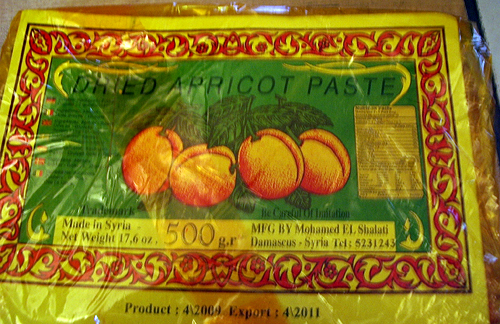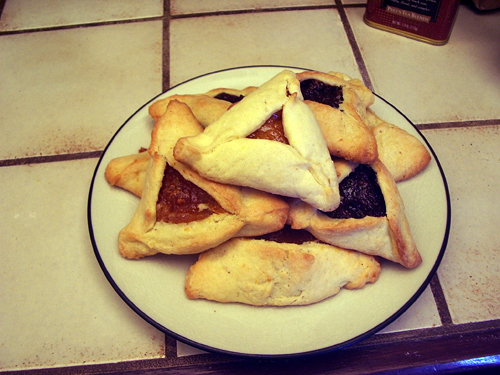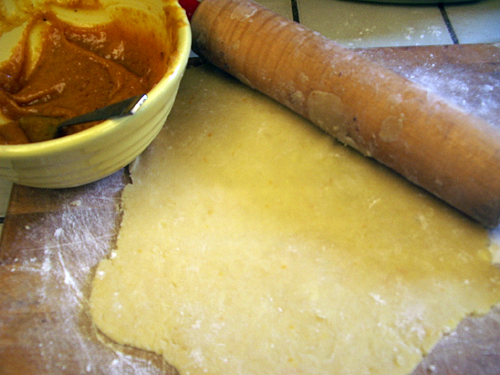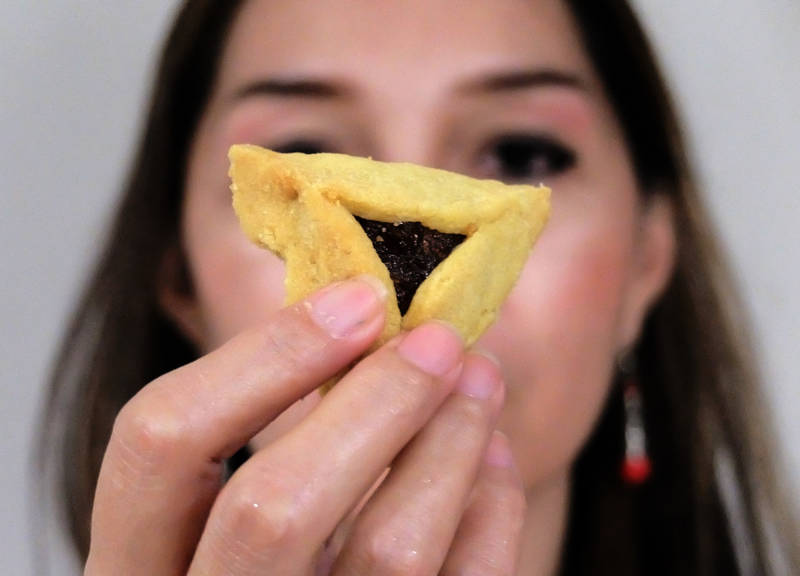You will, however, need to make a special trip for the apricot paste. Any shop specializing in Middle Eastern groceries will carry this, essentially a flat brick of lightly sweetened fruit leather. I've only ever seen one brand, made in Syria and wrapped in golden cellophane, with a beautiful blue label painted with bright orange apricots.

While you're there, of course, you can browse for all kinds of other delicious things, like olives, thick yogurt, pink pickled turnips, mint tea, pomegranate molasses, rose-petal jam, baba ghanoush, chunks of halvah ribboned with chocolate, fresh pita bread, crunchy melon seeds, belly-dancing videos, copper pots for making Turkish coffee, sesame candy, and more. I found mine (and all of the above) at Samiramis Imports in the Mission.
Apricot paste in hand, you can divide up the process over a few hours. Make the cookie dough and stash it in the fridge. Make the fillings, apricot first so you can reuse the pot and the blender without needing to wash them, since the darkness of the prune will absorb any remaining apricot stickiness. Roll out the dough, cut the rounds, move them onto cookie sheets and let little hands plop on the filling and pinch the three-cornered triangles. Bake, make tea or pour milk, and celebrate. And then bring a plateful to your neighbors.
Hamantaschen
Both dough and fillings keep well in the refrigerator, so you can roll out and fill just a few cookies at a time. Then again, these are really delicious and fun to eat even for breakfast, since they're not overly rich or sweet. In my experience, even a whole batch doesn't last very long out of the oven.
Makes: about 20 cookies

Ingredients:
8 tbsp (1 stick, 4 oz) butter or margarine
1/2 cup + 2 tbsp sugar
1 egg
1 tsp vanilla
1 1/2 tbsp orange juice
1/2 tsp grated lemon rind
2 cups flour
1 1/4 tsp baking powder
1/4 tsp salt
Apricot and/or Prune Lekvar, recipe below
Preparation:
1. Cream butter and sugar until fluffy. Beat in egg, orange juice, and vanilla. In a separate bowl, whisk together flour, baking powder, and salt. Stir flour into butter mixture, mixing gently until just combined. Add lemon zest and stir until dough is smooth.
2. Form into a ball, wrap in plastic wrap or pop into a resealable plastic bag.
Chill in the refrigerator for at least 2 hours or overnight. (Otherwise dough will be too sticky to roll out.) While dough is chilling, making filling(s).
3. Preheat oven to 375 F. Lightly flour a large wooden cutting board or countertop. Because this dough tends to be sticky, it's easiest to roll it out with a sheet of waxed paper between the dough and the rolling pin. This will prevent the dough from sticking and tearing as you roll.

4. Roll out dough into a broad round, as if you're making a thickish sheet of pie dough. It's better to have it on the thicker side, maybe a quarter-inch or so, as the cookies are nicer when they're a little puffy, and also will be easier to fill and pinch if they're not super-skinny.
5. Using a cookie cutter or a drinking glass, stamp out circles of dough. Move the circles onto a cookie sheet, leaving an inch or so between each one. It's important to fill the rounds on the cookie sheet (rather than on the counter top) as they are hard to move without tearing once they're filled. The size is up to you; I usually use a cutter that's about 4 inches across, making a round the size of a smallish hamburger patty.
6. Place a generous tablespoon of filling in the center of each round. Fold the top sides of the circle into the middle and pinch the top into a point. Fold the bottom half up to meet the folded-in sides. Pinch each side to seal, forming a triangle with a patch of filling peeking out from the middle.
7. Bake for 20 minutes or so, until cookies are pale golden brown around the edges. Let cool on a rack. Note that the filling will be super-bubbling hot right out of the oven, so try to give them at least a few minutes' cooling time before you bite into your first one.
Apricot Lekvar
Ingredients:
7 oz apricot paste
1/2 cup water
2 tbsp lemon juice
2 tbsp orange juice
1 tablespoon grated orange zest
1/2 cup golden raisins
2 tbsp sugar or honey, or to taste
Preparation:
Tear apricot paste into bite-sized pieces. Place in a small, heavy saucepan with the rest of the ingredients. Warm over low heat, stirring frequently, until paste is soft and melting and raisins have plumped up, about 10-12 minutes. Let cool for a few minutes, then transfer to a food processor or blender. Puree until smooth. Taste and add more sugar or orange juice, as needed. Store in the refrigerator until needed. (If you have extra, it keeps for a very long time and is excellent on toast.)
Prune Lekvar
Ingredients:
1/2 cup water or orange juice
2 tbsp lemon juice
1 cup pitted prunes
1/2 cup raisins
2 tbsp sugar or honey
1/8 tsp cinnamon
Preparation:
Mix all ingredients together. Put them into the same pot you used for the apricot filling (no need to wash it out), and warm over low heat until prunes and raisins are soft and mushy, about 8-10 minutes. Let cool slightly, then puree. Store in the fridge until needed. Like the apricot filling, it keeps a very long time and tastes divine.



